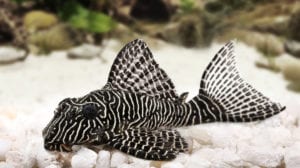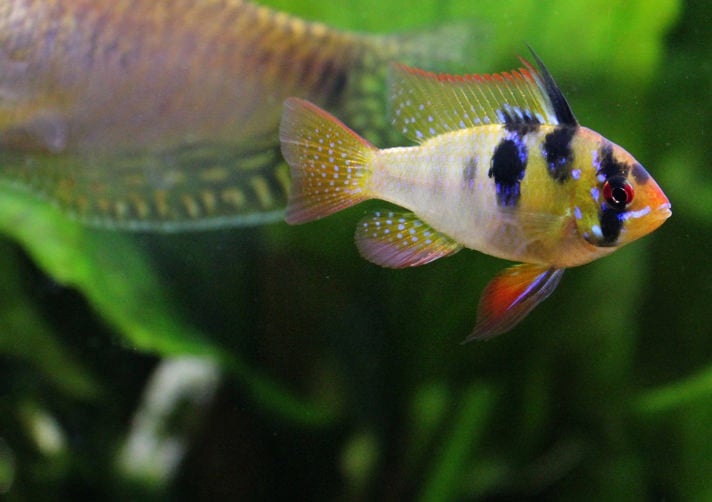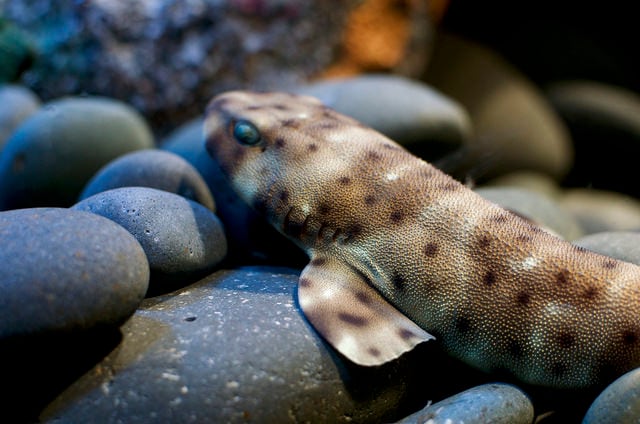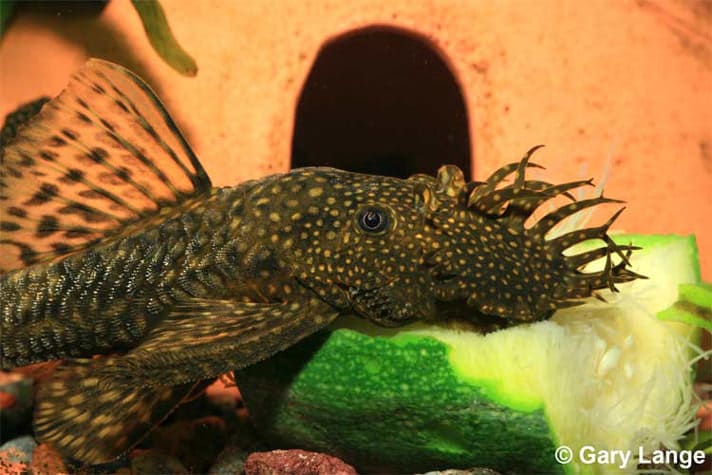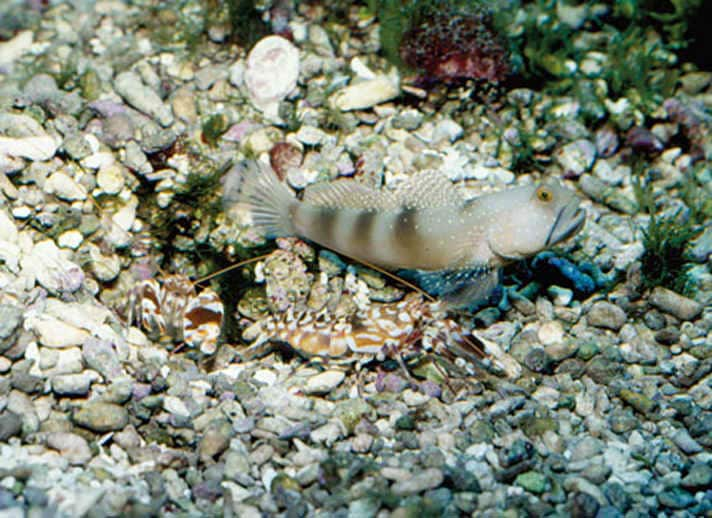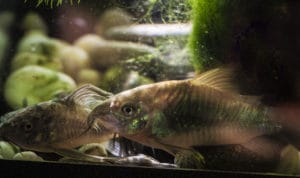Most aquarists either view plecostomus as magnificently beautiful or “hopelessly unfortunate.” They enjoy tremendous popularity in the aquarium hobby. Plecos have become synonymous when describing the largest family of catfishes, the Loricariidae (pronounced Lohr-eh-care-e-id-day). Hobbyists commonly refer to them as “plecos” or “plecs,” and these common umbrella terms cover species from genera such as Hypancistrus, Pterygoplichthys, Ancistrus, Panaque and Peckoltia. The suction-cuplike mouths of these fish help to derive the scientific name of Plecostomus (pronounced ple-cah-sta-muss). This genus name is a combination of pleco (“folded”) and stomus (“mouth”), which together means “folded mouth.” Most members of the Loricariidae belong to the subfamily Hypostominae.
These fish naturally range from Central America to South America and are found on both sides of the Andes Mountains as far south as Argentina, which includes some subtropical locations. Their habitat varies from swift mountain streams to backwater areas, soft-water brooks and even slightly brackish estuaries. Populations of plecos have been established worldwide as a result of irresponsible releases. For example, the common pleco (Hypostomus plecostomus) is now widely established in Florida’s freshwater and brackish waterways.
Identity Crisis
In the past 20 years, there has been a surge of newly discovered members of Hypostominae, resulting in delayed and sometimes conflicting scientific identification. Many of these fish are completely new to science. Ichthyologists find the numbers of new species to be overwhelming.
Exporters compound the identification problem as newly discovered fish, hastily being shipped, are given common names. The situation has become intolerable because competing exporters assign identical species a multitude of nonsensical names. As a stopgap measure, an imprecise numerical identification system is applied to many of the approximately 450 members of this group of suckermouth armored catfishes.
The most common numerical arrangement used is the hobbyist L-number system. The “L” from Loricariidae is followed by a numeral or numerals, and sometimes alphabetic suffixes. For example, in the March 2010 issue of Aquarium Fish International, David Lass authored an excellent Acanthicus adonis species profile. This fish is currently identified as Adonis L-155. L-numbers were sometimes recycled when fish became scientifically identified. This created confusion if numerical lists were not periodically updated. This practice has pretty much been discontinued, but old lists still circulate, muddling an already difficult situation. Just make sure to check the date of the L-number if you are relying on this system. Alphabetical suffixes are used to denote virtually identical specimens; these perhaps resulted from the difficulty encountered when comparing juveniles to adults or slight variations, due to the region of collection. The best we can do for now is to try to use a common name with an L-number and share photos and descriptions with other hobbyists. Added to the alphanumeric code is the F-number. F-1 is often used to identify the first generation of captive-bred specimens.
Description
The subfamily Hypostominae represents more than half of the Loricariidae family and is replete with diversity. A dorsal view (top of the fish as viewed from above) reveals a rather flat body, but variations of body shape, coloration and size make it virtually impossible to provide a single description, other than saying all types have suckermouths and some degree of armor plating (called scutes). All members except those of the tribe Rhinelepini have omega eyes. The pupils resemble the upside-down Greek letter O and are capable of dilation based on ambient light. Rhinelepini have a normal circular iris. The suckermouth allows these fish to eat, breathe and fasten themselves to objects (useful in heavy currents). Suction is achieved by the fish inflating its lips surrounding the suction pad, which creates a tight vacuum. They are capable of maintaining suction in one spot for many hours.
Dorsal and ventral spines not only allow the fish to wedge itself in crevices but provide excellent protection against many predators. At a pet shop, I personally observed an oscar attempting to eat a pleco. Once it got into the oscar’s mouth, the pleco extended its dorsal and ventral fins, and three-fourths of it was wedged into the oscar’s mouth. It was stuck there for more than two weeks until the shop owner summoned the assistance of a veterinarian.
Because of their spines, numerous plecos are injured by frustrated hobbyists when attempting capture. Plecos are covered with sharp, pointed armored scutes and have spiny finnage that can become hopelessly entangled in aquarium nets. Plecos are lightning-fast when chased through an aquarium by clumsy hands. The best way to capture a pleco is with a baited fish trap or gently corralling them into a large plastic cup or bucket. Another method of capture is to slowly corner the fish and gently lift it from underneath, while using your thumb to apply slight pressure to the top of the head and guiding the fish into a container. Hobbyists have reported observing plecos swimming to the surface, and they wonder if the plecos are breathing air. Many plecos dart to the surface for a gulp of air just like other catfish and are able to breathe slightly through their digestive tract.
Misunderstood fish
Plecos really need to be researched prior to purchase. Unfortunately, many of them are sold to inexperienced hobbyists who eagerly anticipate that their pleco will dutifully rid their aquarium of unwanted algae. They are also sometimes sold as tank cleaners requiring no additional food other than what can be scavenged. This often results in starved fish and disappointment. While there are true vegetarians among these fish, many are omnivorous, and some are carnivores and will not live on algae. Plecos will not eat what other fish refuse. They must be deliberately fed fish food specific to their needs.
Pet shops report that many plecos are returned after the owner discovers the pleco is incompatible with their other fish or has simply outgrown the aquarium. Some of these fish grow to enormous sizes, and research should be conducted prior to any purchase. Many plecos are nocturnal and only become active and forage for food when other fish are resting. They need to be fed during this time. There are reports of plecos attaching themselves to the sides of a tankmate and sucking on its coating of mucus. It is speculated this is done because the pleco is starving and trying to “leech” off another fish. If they are observed eating a dying or dead fish, it is likely because the pleco is starving rather than an act of aggression.
Selecting a Pleco
Here are a few useful tips for ensuring success with a pleco:
1. Select the fish based upon its adult size. Almost all plecos for sale in pet shops are juveniles. Some captive plecos grow to more than two feet in length and deserve a spacious aquarium. Plecos can easily live for 10 or more years, so plan for the long-term.
2. Make the selection based on the habitat needs of the fish. Some plecos are voracious herbivores, and an expensive mess will result if they are placed into a heavily planted tank. Plecos are capable of uprooting plants faster that a large cichlid.
3. The temperament and compatibility with other fish, especially other plecos, needs to be carefully considered. Sometimes, new plecos can be introduced, but because plecos are very territorial, deadly aggression results. If you want more than one pleco, consider introducing them at the same time into a new, spacious environment. Plecos can become quite aggressive as they reach maturity, and they require either their own aquarium or community tanks much larger than what most hobbyists are able to keep.
4. Take into account the water quality (pH, hardness, etc.) of the species you are considering. Also remember to check on the temperature range that the pleco requires. A number of plecos are semitropical and live in fairly cool water.
5. A number of plecos originate from log-strewn rivers and streams. Many are active during twilight and desire shelter from bright light, so include logs and rock caves to accommodate them. Numerous plecos even have a need to gnaw on wood. Other plecos really do best in water flowing much faster than the other species in your tank can stand. Try to avoid mixing plecos needing this kind of environment with a large, slow-moving, docile species.
6. Avoid any impulse purchases. Do not succumb to “I’ve got to have that one now!” If it is a specimen you think you must own, leave a small nonrefundable deposit to hold the fish for a day while you do your research. Good pet shops will gladly accommodate you and apply your deposit toward the purchase of this or another fish. It is cruel to purchase and transport a fish home, only to learn later that it will not live the life of luxury all of our fish deserve.
Popular Plecos
I am going to recommend a few plecos based on the following criteria. The following plecos are less than $100 each, suitable for a 55-gallon aquarium when fully grown, easy to care for and readily available from multiple sources.
Ancistrus species, L-144 and L-144a. This fish is available in black (L-144), albino (L-144a) and other colors.
- Size: 4 to 5 inches
- Temperament: Peaceful
- Temperature: 74 to 79 degrees Fahrenheit
- Diet: Omnivore. Provide your bushynose with a mixed diet that includes meat (i.e., bloodworms).
- Habitat: Provide wood for this species to gnaw on, and provide it with shelter, such as rocks, for it to hide. Brisk-moving, clean water is needed.
- Description: The male is identified by its large bushy whiskers. Females have very stubby whiskers (if they have them at all). It has been successfully bred in the aquarium, making it particularly appealing. The mortality rate of some wild-caught plecos is staggering.
Medusa head pleco (A. ranchulus), L-34. These plecos sell fast, and you might have to reserve one.
- Size: 5 to 6 inches
- Temperament: Generally peaceful but probably should not be mixed with other bottom-dwellers.
- Temperature: 74 to 79 degrees
- Diet: Omnivore. Feed it a mixed diet, and include bloodworms.
- Habitat: Provide wood and overhead shelter to allow it to hide.
- Description: The head is covered with stubby appendages resembling the hair of the mythological Medusa. This is a plant-safe fish, but it likes to dig while foraging and could possibly uproot smaller plants. Provide wood and caves for its shelter.
Snowball pleco (Peckoltia sp.), L-102. This strikingly beautiful pleco is in high demand and commands a premium price.
- Size: 6 inches
- Temperament: Peaceful
- Temperature: 74 to 82 degrees
- Diet: Omnivore. Not a particularly good algae-eater. Supplement its diet with bloodworms.
- Habitat: Provide it with wood for gnawing and rocks for shelter.
- Description: This fish is characterized by a black body splattered with vibrant white spots. It has been successfully captive-bred.
Thomasi pleco (Chaestostoma sp.), L-88. These plecos sell quickly.
- Size: 6 to 8 inches
- Temperament: Very gentle
- Temperature: 75 to 80 degrees
- Diet: Omnivore. Provide it with a mixed diet.
- Habitat: Provide it with wood for gnawing and rocks for shelter.
- Description: This fish looks expensive with its golden body accented by black stripes. The head is spotted, which gives it the appearance of a crown of jewels. Breeding data is unavailable, but given its reasonable price, I suspect that it is captive-bred.
Add a Pleco!
With so many magnificent choices, it is easy to understand how a number of hobbyists are solely dedicated to keeping just plecos. Some Internet sites are dedicated to a specific genus of pleco, while others encompass the entire Hypostominae subfamily.
Plecos are a wonderful addition to an aquarium. They are generally peaceful, and if provided with the proper conditions, they will live for many years in the home aquarium.
Posted by: Chewy Editorial
Featured Image: Mirko Rosenau/Shutterstock
Share:
